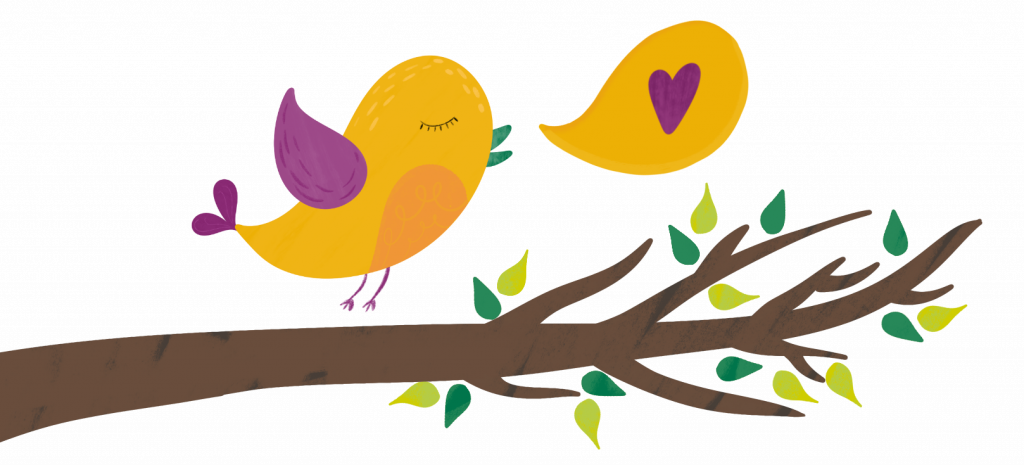Are you in need of a research-based routine for teaching the short vowel sound of the letter u to preschool or kindergarten children?
Do you get the feeling that there could be a better way to introduce letter sounds, something more effective and engaging than what you find in your current curriculum?
If so, I’d like to share a simple, effective, and enjoyable routine with you. It’s based on solid reading research and something I’ve been using for years with great results!
When you are teaching letter sound u, most programs will ask you to follow a script like this:
“This is the letter u. U says /ŭ/, as in up. Repeat after me. U, up, /ŭ/.”
When I taught this way, most students eventually caught on. But there were too many kids, especially children at risk for reading struggles, who took so long to master and RETAIN letter sounds, that I wondered if there was a better way.
And there was! After years of diving into research studies and professional books, as well as signing up for every structured literacy training I could attend, I began making changes to my instructional routine of teaching letter sounds and have seen amazing progress.
Below you’ll find a short explanation of the steps I follow and why they work. I hope you’ll find something new to try with your own students.
Routine for Introducing the Letter U and Its Short Sound
You can watch this video to get an idea of the entire routine. You can also play it for your students!
Start with speech.
Why?
We know that activating prior knowledge is an effective strategy to teach any new concept. It’s how we make new learning stick. So by beginning our lesson with spoken language, and even better – pairing it with visuals – we allow students to build on existing knowledge and better connect new information like printed letters. Since speaking comes naturally and reading does not, starting our instruction with something easy and familiar (such as talking!), and THEN relating that speech to print, provides our children with a solid foundation for learning to read and write.
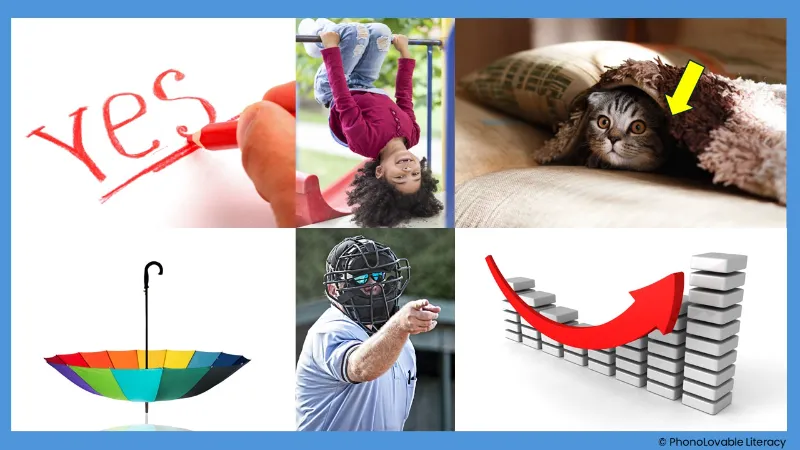

How?
Tell students that you are going to say a few words and their job is to listen carefully and repeat what they hear. You can also vary your voice for each word, just for fun. Say 3-6 words that begin with the short sound of the letter u, such as under, umpire, umbrella, and up. Ask students to repeat each word (while you show images of the words if you can). Tell children that all of these words begin with the short vowel sound /ŭ/.
Draw attention to your mouth when you make the short vowel sound of u.
Why?
When we guide students to SEE and FEEL what happens when we make a certain sound, we help add more meaningful connections between letters and sounds. This process makes an abstract concept more concrete.
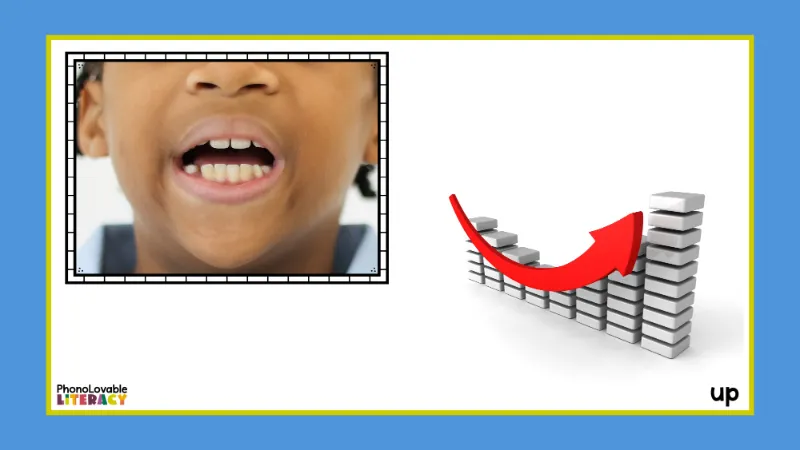

How?
To make the short u vowel sound, you need to open your mouth slightly and drop your chin a little. Your mouth doesn’t need to open as much as when you make the short a sound, for a contrasting example. Model this for your students and/or show a sound articulation card (“mouth pic”) such as the one above.
When students begin blending individual sounds into words (a.k.a. decoding), it’s helpful if they really stretch out the vowel sound. This greatly benefits students with limited working memory. If you ever have students who sound out /p/…/ŭ/…/g/ and they say something like “goat”, you know what I mean. They can only hang onto that last sound in their memory, so they just guess at a word that begins with /g/ and hope for the best. But if they can blend the /pu/ and hold onto that short u sound until they slide into the /g/, they’ll be more likely to read the word accurately.
I like to build this “stretching out” habit early, so each time we learn a new vowel, I challenge them to hold onto the sound as long as they can. For the short u sound, we use a gesture of simply pointing up to the sky while stretching out the sound. Have fun with this by switching up the tone and/or volume of your voice as you hold onto the sound and ask students to do the same.
Introduce the printed letter with an EMBEDDED mnemonic.
Why?
The research on this is strong and just makes a lot of sense. Using embedded images, keyword pictures displayed within the letter as opposed to separate from the letter, resulted in students improving both the acquisition AND retention of letter-sound correspondences. In fact, it was more effective and efficient than the other methods studied, such as using a keyword picture next to the letter, or using just a keyword for each letter (no pictures). What you’ll find in many phonics programs today are keyword pictures next to the letters, unfortunately, but embedded letters have been making a comeback in the past few years!
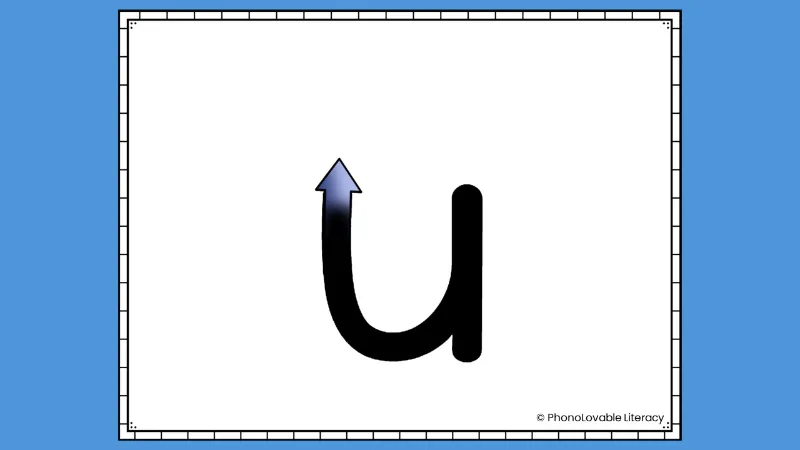

How?
Here is where you’ll first show your students the actual letter. But not just a plain letter, an embedded letter. The image of a keyword such as an arrow pointing up embedded in the letter u helps solidify the connection between letter and sound.
Model and practice how to write the letter.
Why?
Reading and writing are interrelated skills, and they should be taught together. Besides guessing at words, I’d say the second most common habit I see young students develop is inefficient letter formation. For the past few years, I’ve made it a point to prioritize letter formation as early as possible to prevent bad habits from forming. We teach phonemes and graphemes together so that students may not only read new words but learn to write them as well.
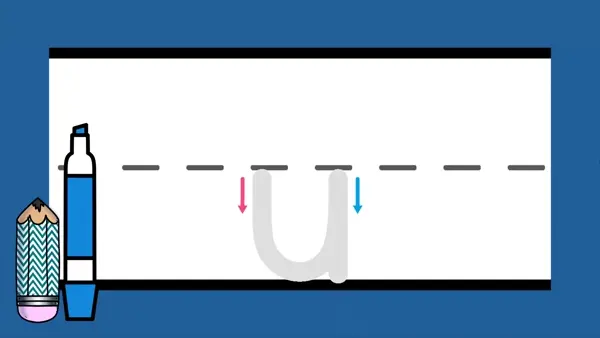

How?
I find most letter formation scripts in teacher’s guides to be unnecessarily wordy. I like to keep my language simple so students are more likely to memorize it. You may have different wording from a program you’ve used, or you may wish to change up how you say this, but here’s what I say as I model how to write the lowercase letter u.
“Start at the middle. Little line down. Touch the bottom, curve it up (to the middle line), and pull it back down (to the bottom line).” I model with my hand in the air and/or show an animated slide on my computer (in small group) or smart TV (in whole group). Ask students to follow along with their fingers in the air. If children are seated at desks, ask them to finger-write the letter u on the desk.
I usually have students practice without a writing utensil a few times before I ask them to write with a dry-erase marker or pencil. This is just so I can make sure they’ve got the movements down before they put it on paper.
Research-Aligned Alphabet Resources
Need easy-to-use resources to implement the steps above?
Here are my recommendations for introducing the letter u and other letters to your preschool or kindergarten students:
Initial Sound Slides: These no-prep slides introduce each letter sound in the most effective and efficient way. With each click, you will show images of interesting photographs containing the beginning sound, a photo of a child making the sound along with a keyword image, the letter with an embedded mnemonic image, and lastly, an animated letter formation slide (one for uppercase and one for lowercase letters).
Mnemonic Alphabet Articulation Mouth Cards | Alphabet Posters with Real Pictures: If you prefer a paper option or don’t have access to digital resources, you may like these printable, 1-page posters of mouth pics along with the embedded mnemonic letters. It’s also a nice way to display the alphabet if you have classroom wall space.
Alphabet Picture Cards with Embedded Mnemonics: This set of printable pages comes with embedded letter cards in two sizes. Teach phonemes for 21 consonants, 5 short vowels, AND consonant digraphs WH, TH, SH, CH, and CK.
Want a free set of small embedded letter cards? When you join us in our newsletter community, we’ll send you a complementary set as a thankyou gift!
Looking for an “everything bundle” of embedded letter resources, including digital slides, letter cards, worksheets, games, and more? Get your students quickly and effectively mastering letter sounds so they can begin the exciting journey of reading and writing words! Current savings are at nearly 50% off for all 12 resources!


Sources:
Ehri, L. C., Deffner, N. D., & Wilce, L. S. (1984). Pictorial mnemonics for phonics. Journal of Educational Psychology, 76(5), 880–893. https://doi.org/10.1037/0022-0663.76.5.880
Ehri, L. C. (2013). Orthographic Mapping in the Acquisition of Sight Word Reading, Spelling Memory, and Vocabulary Learning. Scientific Studies of Reading, 18(1), 5–21. https://doi.org/10.1080/10888438.2013.819356
Ehri, L.C. (2022). What Teachers Need to Know and Do to Teach Letter–Sounds, Phonemic Awareness, Word Reading, and Phonics. The Reading Teacher, 76(1), 53-61. https://doi.org/10.1002/trtr.2095
McNamara, G. (2012). The effectiveness of embedded picture mnemonic alphabet cards on letter recognition and letter sound knowledge. Theses and Dissertations. 302. https://rdw.rowan.edu/etd/302
Shmidman, A., & Ehri, L. (2010). Embedded Picture Mnemonics to Learn Letters. Scientific Studies of Reading, 14(2), 159–182. https://doi.org/10.1080/10888430903117492
